

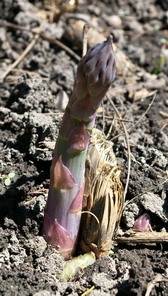
We’ve had unseasonably warm early weather that brought out many of the bulbs and then a long cool period that has kept them in bloom. However, spring has now truly arrived, we ate our first fresh Asparagus this past weekend. That rich, fresh taste and texture are a wonderful reward for the time and effort expended on the garden. What a wonderful vegetable. Plant it once, wait for a couple of years while it establishes and then enjoy it for the next thirty years. Its mid-summer, fern like foliage, also makes a great backdrop for summer flowering perennials if you have been clever enough to plant them around the edges of the bed where the Asparagus occupies the centre. Interestingly, the very early spears that started to emerge in the March heat wave, did not continue to develop. They were brown and mushy as a result of the later cold weather. The garden continues to fascinate and teach, even after a lifetime of Dallying In The Dirt. 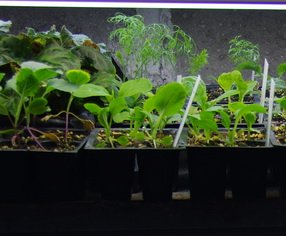 The hoe and trowel are sharpened and the seed packages and transplants are ready. The early vegetables are anxious to find their home in the warming soil. Pak Choi and Guy Lan are significant additions to our mainstream vegetable palate from the oriental palate. Broccoli, Cauliflower and Rapini will produce a great early spring crop, planted now, as well as a late autumn crop when planted mid summer. Peas and Carrots are just a couple of the vegetables that can be seeded directly in the garden this week. Of course we cannot forget the several types of Onions that have been developing in the cold frame for the last several weeks.
The hoe and trowel are sharpened and the seed packages and transplants are ready. The early vegetables are anxious to find their home in the warming soil. Pak Choi and Guy Lan are significant additions to our mainstream vegetable palate from the oriental palate. Broccoli, Cauliflower and Rapini will produce a great early spring crop, planted now, as well as a late autumn crop when planted mid summer. Peas and Carrots are just a couple of the vegetables that can be seeded directly in the garden this week. Of course we cannot forget the several types of Onions that have been developing in the cold frame for the last several weeks.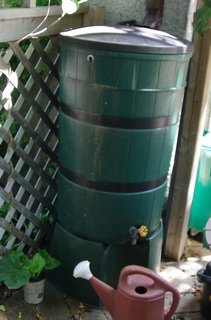 The garden is quite dry this year because of the early warm weather and that will allow for a little crop rotation. The early vegetables can go in the southern portion of the garden which is always the slowest to dry up. Later in the year the warm weather crops can go north to occupy a place they haven’t been for some time. Moving things about in the garden is a healthy practice. Soil borne diseases have a tougher time finding their hosts and different plants have some slightly different nutritional desires that might be better served if they are growing in a new location. Most of us backyard farmers really don’t have the room to do significant crop rotation but we can try to make those nasty diseases have to search a few metres to find their host plants each year. The dry soil in mid April, actually causes me some concern. There is not enough moisture to even germinate the seeds and we would actually appreciate a good soaking rain. I have the rain barrels in place in anticipation but they remain empty. This may be the year that I should finally get my act together and install the drip irrigation system in the section of the garden where most of the vegetables grow.
The garden is quite dry this year because of the early warm weather and that will allow for a little crop rotation. The early vegetables can go in the southern portion of the garden which is always the slowest to dry up. Later in the year the warm weather crops can go north to occupy a place they haven’t been for some time. Moving things about in the garden is a healthy practice. Soil borne diseases have a tougher time finding their hosts and different plants have some slightly different nutritional desires that might be better served if they are growing in a new location. Most of us backyard farmers really don’t have the room to do significant crop rotation but we can try to make those nasty diseases have to search a few metres to find their host plants each year. The dry soil in mid April, actually causes me some concern. There is not enough moisture to even germinate the seeds and we would actually appreciate a good soaking rain. I have the rain barrels in place in anticipation but they remain empty. This may be the year that I should finally get my act together and install the drip irrigation system in the section of the garden where most of the vegetables grow.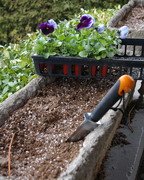 Planting some cool weather flowers such as Pansies, in the front porch containers, is a job I could have done much earlier this year but it will happen this week. They do a great job brightening up the entry and will continue to do so until mid June when they will be replaced by warmer weather crops such as Impatiens. The Sweet Peas are growing nicely under the lights in the basement and will be interplanted with the Sugar Snap Peas when they get seeded in the garden in the next few days. I didn’t start any Calendulas this year but they are another annual flower that can thrive when planted in the cool days of early spring.
Planting some cool weather flowers such as Pansies, in the front porch containers, is a job I could have done much earlier this year but it will happen this week. They do a great job brightening up the entry and will continue to do so until mid June when they will be replaced by warmer weather crops such as Impatiens. The Sweet Peas are growing nicely under the lights in the basement and will be interplanted with the Sugar Snap Peas when they get seeded in the garden in the next few days. I didn’t start any Calendulas this year but they are another annual flower that can thrive when planted in the cool days of early spring.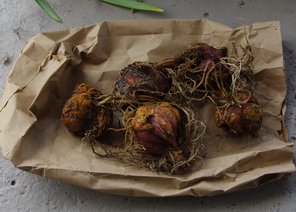 Despite the constant hunt for Red Lily Bugs that keeps a pair of needle nosed pliers as my constant companion in the garden, I still love my Lilies. I am going to be planting the few, (I cannot mention how many because the Assistant Gardener reads Dallying,) new Lily bulbs that I purchased at our Canada Blooms show. Most of them are the newer hybrids that are being developed between the various types of Lilies such as the Oriental - Trumpet Hybrids that are producing stunning new types to expand the size and colour range in our Lily collections.
Despite the constant hunt for Red Lily Bugs that keeps a pair of needle nosed pliers as my constant companion in the garden, I still love my Lilies. I am going to be planting the few, (I cannot mention how many because the Assistant Gardener reads Dallying,) new Lily bulbs that I purchased at our Canada Blooms show. Most of them are the newer hybrids that are being developed between the various types of Lilies such as the Oriental - Trumpet Hybrids that are producing stunning new types to expand the size and colour range in our Lily collections. Time to answer a few questions. If you have a gardening question just ‘reply’ to this newsletter and send me your query. I try to answer most of the questions and the ones that I answer here are those that I think will have the widest interest. You can also find the latest garden updates on the front page of gardening-enjoyed.com . Stacey Asks? We have a nicely landscaped garden in our front yard that is in an inverted u-shape as you face the house. This leaves a somewhat circular patch of grass (or beautiful collection of weeds) maybe about 7' wide or so, on the north side of our house. I would like to get rid of the grass and put something else there but don't want to wreck the appearance of the garden that's already there. Any ideas? Ken Answers! It is difficult to answer landscaping questions without visiting a garden but assuming that you want something short, like grass, but with much lower maintenance, try a bed of some of the smaller varieties of Hosta or, as I did last fall, replace the grass with creeping thyme. Linda Asks? I was wondering what would you recommend as a good lawn fertilizer/weed killer. Also when can I put grass seed on my lawn to fill in spots and what grass seed do you suggest? I am enjoying your newsletter and thanks for all your great advice. Ken Answers! It is difficult to recommend fertilizer and weed killers as the availability of various chemicals varies depending on your location. Turf fertilizers should have a high concentration of Nitrogen, with much of it in a slow release form. Grass seed, for fill in, can be applied now. Use a quick germinating type, such as one of the many new varieties of perennial rye grass and try to keep it moist for the week or so that it will take to germinate. Tomato Grower Asks? I started some tomatoes indoors from seeds and transplanted them into 5 gallon pails. I have been putting them outside during the day and bringing them back in at night. I have noticed a rash on the leaves and did some research and it is kind of hard to identify for myself, looks close to wind whipping or a spotting virus, not sure really. Ken Answers! From your pictures, I might suggest that your tomatoes are a bit hungry. Do you fertilize them? Putting them outside on a very cool day will get them lots of light but they really don’t like cool weather. The soil in your pails appears to be quite heavy, containing a fair amount of garden soil and that does not promote the best growth. Any, all or none of these might be part of your problem. Now a comment from a reader: Hi! How can "we" tell Annette with the dog urine problem to talk to her vet? My son-in-law has a large, female dog and during the green season, so to speak, he gives her a pill when he feeds her and it neutralizes the whatever in her urine so it doesn't leave yellow spots. Pat in Memphis. Ken comments I must check with my veterinary son-in-law to see if such a thing is available in our part of the world. 111 Trent St. W. Whitby ON L1N1L9 |
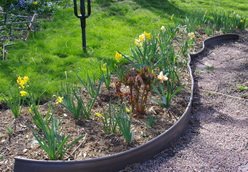 The
The 